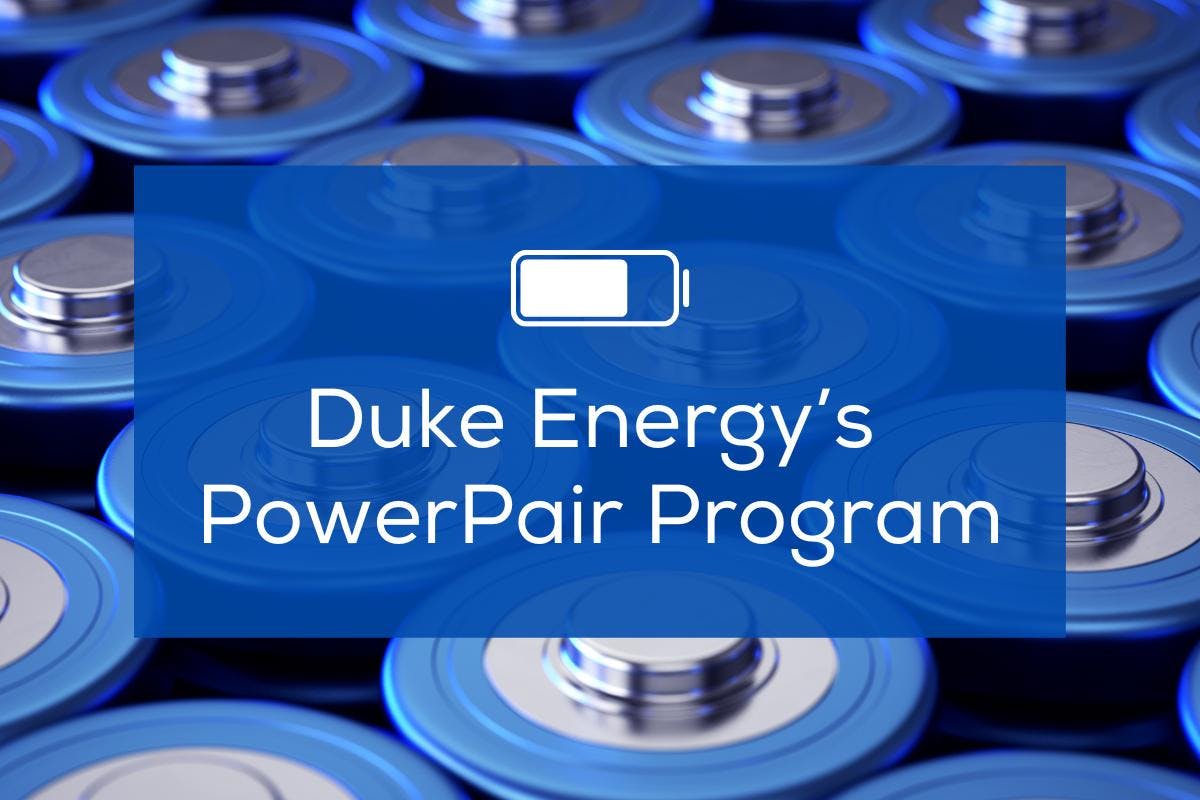In March 2023, the North Carolina Utilities Commission (NCUC) rejected a Smart thermostat + solar incentive program proposed jointly by Duke and the solar industry. Instead, they ordered Duke to propose a residential solar + storage pilot program for Commission consideration. In June, 2023, Duke filed the proposed PowerPair Solar and Battery Installation Pilot. Following a lengthy stakeholder process, the NCUC issued a final order on January 12, 2024 approving the PowerPair Program. Duke will have until May 10, 2024 to launch the PowerPair Program. The following is a summary of the key highlights of the new program:
See how much you can save by going solar with Palmetto
What does the PowerPair Program mean for consumers?
Ultimately, this program makes pairing storage with a new solar system more affordable. The average solar battery costs between $400-$750 per kilowatt-hour (kwh), meaning an average solar battery typically costs between $10,000 and $20,000 when you factor in installation costs. Under the new PowerPair Program, eligible consumers could receive up to $9,000 to cover applicable solar and energy storage costs. For example, a homeowner who was to install a new 10 kw solar system, an average sized solar sytem, the incentives of this program would total $7,600 ($3,600 for a solar incentive + $4,000 for a storage incentive), and individuals in Cohort B would be eligible for ongoing monthly incentives.
Who is eligible for the Duke Energy PowerPair Program?
The following eligibility criteria applies:
- Applicant must be a Duke North Carolina customer (DEC or DEP) and own the home the system is installed at.
- The Duke PowerPair rebate is only for solar+storage projects. There are no solar only incentives for residential customers through Duke Energy.
- The application must be for a new solar system install (no system additions are considered) and the consumer must own or lease the equipment.
- Applicants can not have reached commercial operation more than 90 days prior to submitting an application and must reach commercial operation within 270 days after receiving a reservation.
- An Interconnection Approval (ICA) must be submitted before an incentive program application.
- The system installer must first register with Duke Energy to participate in the Program.
- The max export to the grid can not exceed 20 kW AC at any time.
- Internet connectivity must be maintained.
- Only certain eligible battery types can participate.
Program Next Steps
- March 1, 2024: Website live
- May 10, 2024 - June 7: Initial PowerPair application open
- July 9, 2024: Customers can begin enrolling an eligible* battery storage system
Program Caps
The following PowerPair Program caps apply:
- 60,000 kW AC of solar total (~7,500 customers at an 8kW AC system size)
- 50/50 split between Cohort A and B availability (30,000 kW AC each)
Two Participant Groups
Duke has proposed the Program offerings be broken down into two “Cohorts” of customers:
- Cohort A (50% of participants) - Must enroll in Duke’s Successor Tariff w/ mandatory TOU rates. Customer retains complete control of the energy storage device and will receive the upfront solar + storage incentive payment only
- Cohort B (50% of participants) - Must enroll in the Bridge Rate w/ optional TOU rates. Duke assumes control of the energy storage device during called “events” and the customer will receive the upfront incentive payments + monthly battery control incentive.
Incentive Structure
The following incentive structure applies for the PowerPair program:
- Solar incentive: $0.36/ Watt AC up to 10 kilowatt (kW). This incentive is good for one time, up to a max $3,600.
- Storage incentive:
- Cohort A: $400/kWh up to 13.5kWh (one time, max $5,400)
- Cohort B: $400/kWh up to 13.5kWh (one time, max $5,400) + battery control incentive of $6.50/kW/month (nominal/continuous output). The net battery control incentive system owner receives is $4.61/kW/month.
Cohort B - Battery Control
Duke Energy's PowerPair program has a mandatory battery control for Cohort B. This is described as follows:
- Duke Energy will be allowed to remotely call a “control event” 18 times per winter season (Dec- Mar); up to 9 times per summer season (May- Sept); and up to 9 times in remaining months.
- A Control Event will send a signal to the battery and discharge it within 48 hours.
- Duke will not discharge below a 20% state of charge in the battery
- Duke Energy also reserves the right for interruption outside of these parameters in the event continuity of service is threatened.
Application Process
- First four weeks of the Program will be a lottery. If first year Program caps are met during this time, projects will be randomly selected or waitlisted
- If first year program caps are not met during this period, the Program will remain open until the first year caps are met with all additional projects placed on a waitlist.
Tax Reporting
All incentive payments will be reported to the IRS through a Form 1099.
Clawback Provisions
Duke's PowerPair program has the following clawback provisions:
- Early Termination Fee - An early termination fee will be assessed to any project removed from the Program prior to the term and will a prorated based on the months remaining and the total incentive amount paid
- Inoperable equipment charge - This charge will be a monthly proration of the total incentive payment and will be assessed each month following a 90- day grace period. Systems inoperable for 12- months straight after the 90- day grace period will be removed from the Program and have the early termination fee assessed
See how much you can save by going solar with Palmetto
 Cory O'BrienSenior Director - Growth Marketing
Cory O'BrienSenior Director - Growth MarketingCory brings over 8 years of solar expertise to Palmetto, and enjoys sharing that knowledge with others looking to improve their carbon footprint. A dog lover residing in Asheville, NC with his wife, Cory graduated from UCSB. If you run into him, ask him about the company he founded to rate and review beer!

